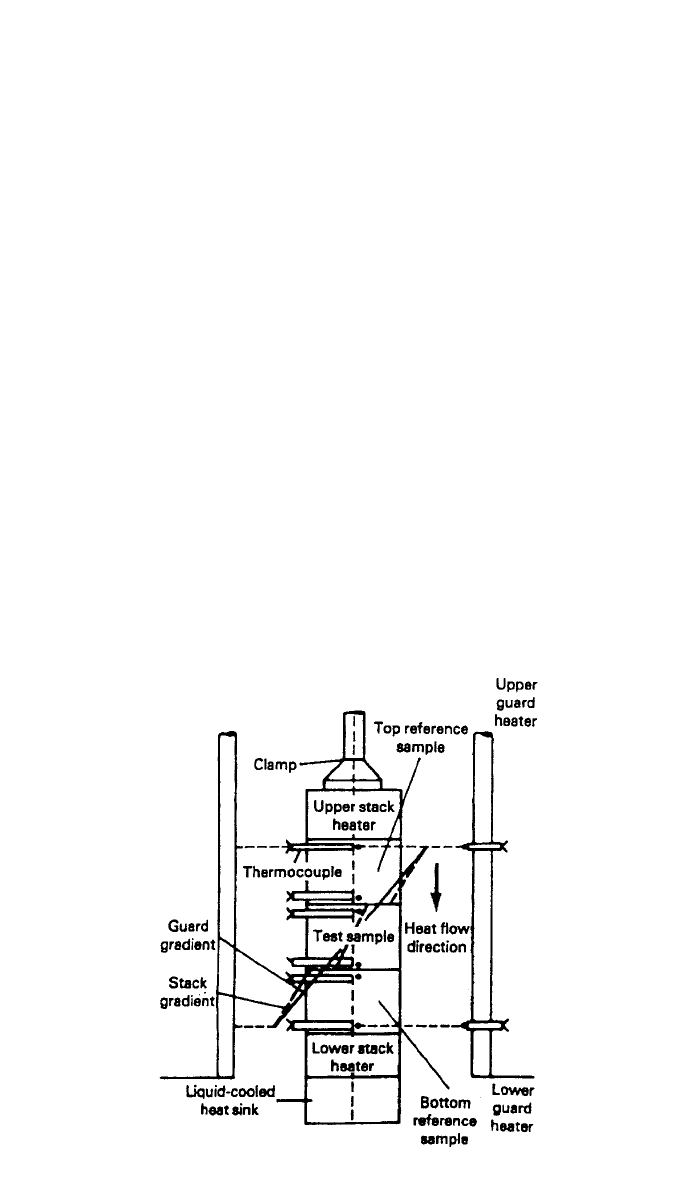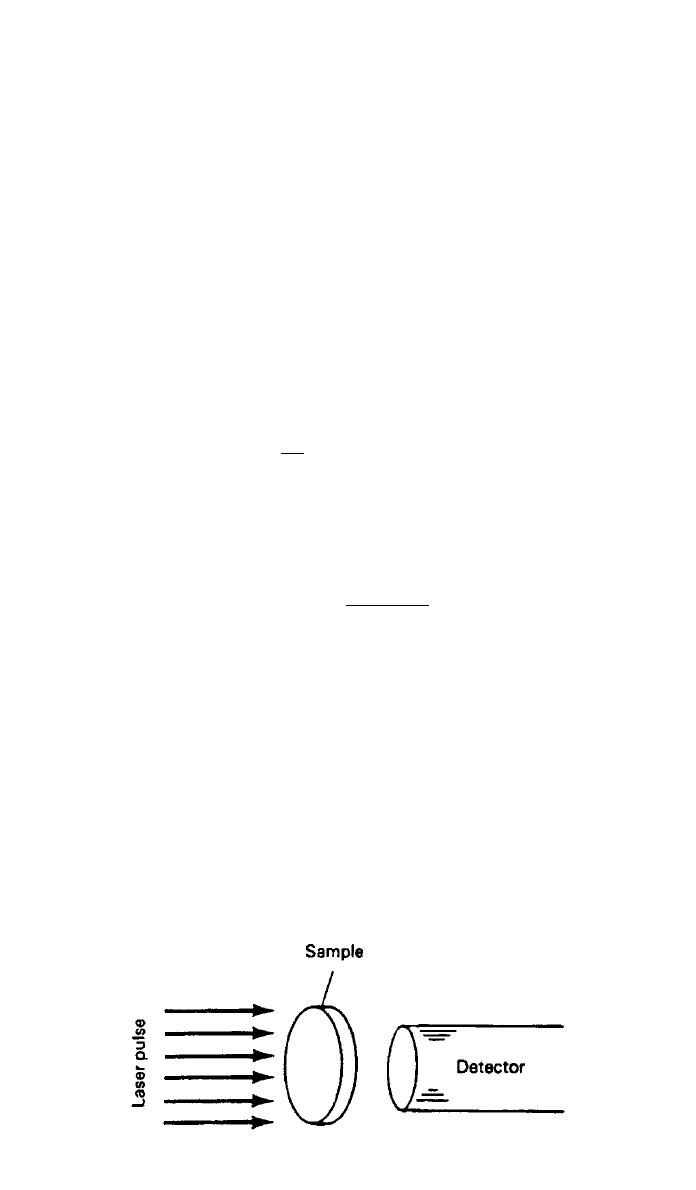Kutz M. Handbook of materials selection
Подождите немного. Документ загружается.


638 CERAMICS TESTING
materials expand when heated and contract when cooled. This characteristic is
valuable to the engineer or scientist involved in ceramic design or research. The
coefficient of thermal expansion (COTE),
␣, is strongly related to the strength
of the atomic bonds. Energy must be put into the material for the atoms to move
from their equilibrium positions. Typically, ceramics, which have strong ionic
or covalent bonds, have lower thermal expansion coefficients than metals. The
average COTE is simply the change in the length of the material per unit length
per unit temperature:
⌬L
␣
⫽
L ⌬T
o
The volume COTE,
␣
v
, is the change in volume of the material for a given
temperature. Consequently, for an isotropic material the volume COT is given
as:
␣
⫽ 3
␣
v
Thermal expansion is a tensor property that is different along individual crys-
tallographic axes.
15
This varying expansion can cause residual stresses in some
test specimens that can actually cause cracks between the crystal faces in some
rare situations. This thermal cycling cracking will manifest itself in the form of
a hysteresis curve from expansion data during thermal cycling tests.
Typically, the COTE is lower for materials having a high melting point. The
linear COTE is a more exact definition and continuously changes with regard to
temperature. The COTE for materials is usually listed in handbooks as a com-
plicated temperature-dependent function or is shown as a constant that is valid
only for a specified temperature range. Taking into account the temperature
dependence of the linear COTE, experimental measuring gives the more exact
equation
15
⭸L(T)1
␣
(T ) ⫽
冉冊
i
⭸TL(T)
T
⫽
T
i
where L(T
i
) is the experimentally measured length of the specimen at a given
temperature T
i
. The difference in the linear COTE and the average COTE is
shown graphically in Fig. 10.
Understanding the thermal expansion of a given ceramic is especially impor-
tant in design applications such as composites that combine structurally distinct
constituents (fiber, matrix, etc.) of different materials (ceramic, metal, etc.) with
different COTE. For example, a ceramic with a low COTE combined with a
metal possessing a high COTE can result in critical stresses for a given temper-
ature change.
Dilatometry
The most popular method for measuring thermal expansion is dilatometry.
15
The
test setup is simple, consisting of a cylindrical test specimen placed between a

3 THERMAL TESTING 639
Fig. 10 Difference in linear COTE and average COTE. (From Ref. 15 Engineered Materials
Handbook, Vol. 4: Ceramics and Glasses, ASM International,
Materials Park, OH 44073-0002, Fig. 1, page 612.)
fixed base and a movable push rod. The ceramic test specimen is heated at a
fixed rate, which displaces the push rod a given distance that is recorded by a
sensing device. Software is readily available to record the data and determine
the temperature-dependent COTE and the average COTE record.
Dilatometers can be of the single or double push rod variety. The single push
rod method involves first calibrating the test apparatus in terms of the change
in length versus temperature-sensing device with a test specimen possessing a
known COTE. Next, the ceramic test specimen is tested compared to the pre-
viously measured standard to determine its COTE. Calibrating the test apparatus
with a standard reference specimen first in this manner can correct for problems
such as dilatometer material expansion, thermal gradients, and nonlinearity in
the heating rate.
15
The double push rod design tests the ceramic test specimen
and the standard reference material side by side. The thermal expansion data is
then calibrated by comparing it with the standard reference material with a
known COTE.
Other Techniques
X-ray diffraction can give insight into the structure of ceramics. The tensor
components of thermal expansion can be determined with X-ray diffraction
through the measuring of changes of the interplanar spacing with relation to the
temperature. One distinct advantage with this method is that only a very small

640 CERAMICS TESTING
sample of the ceramic is required. Another advantage is that measuring the tensor
components of thermal expansion of a specimen is possible with X-ray diffrac-
tion. This can be important when trying to estimate residual stresses that will
occur during thermal cycling.
Interferometry is a technique that involves placing the test specimen between
two reflecting surfaces and measuring the displacement through the movement
of the surfaces. The basis for this being that parallel reflective surfaces a short
distance apart will show interference fringes when illuminated by monochro-
matic light. As the reflective surfaces move apart from the specimen expansion,
the interference fringes move past a reference point on one of the reflecting
planes. The expansion of the sample in terms of length can be expressed as
15
:
⌬L
NA
⫽⫹
L 2LL
where N is the number of interference fringes that pass the reference point, L is
the specimen length, ⌬L is the change in the specimen length, is the wave-
length of the light source, and A is the correction for the light source based on
the atmosphere in the measuring environment. Restrictions on the test specimen
geometry make this technique less popular than dilatometry methods. One ad-
vantage to this technique, however, is that ceramics with volatile components
can be tested by interferometry inside a closed, heated test chamber where the
volatile component’s vapor pressure can be controlled.
3.2 Thermal Conductivity
Thermal conductivity is a measure of the rate of heat transfer in a given material
by conduction. The heat flowrate through a material is proportional to the heated
area of the material and the temperature gradient across the specimen. This
proportionality yields the coefficient of thermal conductivity,
, which is shown
in the following equation
16
:
dQ dT
⫽⫺
A
dt dx
The negative sign on the right side indicates that heat flows from a higher to a
lower temperature. The rate of heat flow is dQ/dt, A is the cross-sectional area
of the material, and dT/dx is the temperature gradient.
Two important mechanisms involved in transferring thermal energy are lattice
vibrations (or phonons) and transfer of free electrons. Valence electrons travel
from hot to cold areas with the energy gained, and then transfer their energy to
other atoms. Many electrons in ceramics cannot be excited into the conduction
band except at quite high temperatures because the energy gap is typically too
large.
16
Consequently, heat transfer in ceramics is primarily a result of lattice
vibrations. This results in ceramics typically having a much lower thermal con-
ductivity than metals. However, not all ceramics have low thermal conductivity.
Advanced ceramics such as AlN and SiC have good thermal conductivity and
low electrical conductivity. Consequently, they are good for electronic appli-

3 THERMAL TESTING 641
Fig. 11 Guarded hot plate test setup. (From Ref. 15 Engineered Materials Handbook, Vol. 4:
Ceramics and Glasses, ASM International, Materials Park, OH 44073-0002, Fig. 2, page 613.)
cations where dissipating heat is a requirement. Thermal conductivity is an
important aspect of materials for microelectronic substrates and electronic
packaging materials. The development of higher density circuits makes heat
dissipation an increasingly difficult problem to overcome.
Guarded Hot Plate
The guarded hot plate technique is a comparative method that measures thermal
conductivity through the application of thermocouples to a cylindrical ceramic
test specimen sandwiched between two cylindrical sections of a reference ma-
terial with the same diameter and with a known thermal conductivity. The test
setup is shown in Fig. 11. Thermally conductive paste is applied to the mating
surfaces to ensure adequate heat transfer between materials. Using a reference
material with a thermal conductivity similar to that of the ceramic test specimen
will yield the best results. Stack heaters at the top and bottom of the cylinder
stack introduce heat into the materials. The thermocouples are positioned near
the mating surfaces on the reference and test cylinders. The thermocouples de-
termine the temperature gradient and then the steady-state heat flux is established
between the stack heaters. Using the thermal conductivity of the reference ma-
terial and the measured temperature gradients in the two test specimen cylinders
sandwiching the reference cylinder, the heat flux through the entire stack can be
calculated using the thermal expansion equation previously given. These two
independent calculations of heat flux through the stack are then averaged, and
the average is used as the heat flux value for the ceramic test specimen. In
addition, the difference in the two calculated values give the heat loss value for
the stack. The coefficient of thermal conductivity,
, can then be determined

642 CERAMICS TESTING
Fig. 12 Schematic of laser flash method test setup. (From Ref. 15 Engineered Materials
Handbook, Vol. 4: Ceramics and Glasses, ASM International,
Materials Park, OH 44073-0002, Fig. 3, page 614.)
because the average heat flux through the stack, the area of the test specimen
cylinder, and the measured temperature gradient along the ceramic test speci-
men’s length are all already known. To eliminate convective heat losses, mea-
surements can be made in a vacuum or reduced atmosphere environment.
Laser Flash Method
Another method for determining thermal conductivity is the laser flash method,
which involves quickly heating a thin ceramic specimen on one side via a quick
‘‘thermal pulse’’ from a laser and then using the measured temperature values
over time of the back face of the specimen to calculate thermal diffusivity and
conductivity. Thermal diffusivity,
␣, is a different means of expressing a mate-
rial’s heat conduction properties. Thermal diffusivity takes into account that heat
can diffuse through a material subject to different boundary conditions, causing
both spatial and temporal variations of temperature.
16
Thermal diffusivity is a
temperature-dependent material tensor property that is defined by the equation
dT
2
⫽
␣
(T)ⵜ T
ij
dt
The relationship between thermal diffusivity and thermal conductivity is given
by the equation
k (T)
ij
␣
(T) ⫽
ij
(T)c (T)
p
where
(T) is the temperature-dependent density and c
p
(T) is the specific heat
capacity of the test specimen.
The ceramic test specimen is in the shape of a thin disk and is at a constant
temperature T, when the laser flash exerts a thermal pulse on the front face.
Figure 12 shows a schematic of the test setup.
The assumptions here are that the thermal energy is deposited uniformly over
the front face of the test specimen, that the heat travels along the thickness of
the specimen only to the back face, and that the pulse heats the sample only.
16
Then, knowing the temperature of the back face at times after the pulse is
introduced into the test specimen, the thermal diffusivity of the test specimen

3 THERMAL TESTING 643
can be calculated using various algorithms. Different available algorithms use
various temperatures of the back face to calculate thermal diffusivity.
An advantage of the laser flash method is that, in addition to having a simple
test setup, it can be used over a large range of thermal conductivities and ceramic
specimen temperatures. Also, it is quite popular for measuring thermal conduc-
tivities at high temperatures as maintaining a steady-state condition is difficult
at higher temperatures.
Other thermal pulse methods using different sources such as electron beams
or quartz flash lamps are also possible utilizing very similar test procedures.
3.3 Heat Capacity
Heat capacity is a property that refers to the amount of energy that must be
added or subtracted from a material to raise or lower its temperature. The amount
of energy required to raise the temperature of a material by a degree varies from
material to material based on its properties. Specific heat at a constant pressure,
c
p
, is the most common expression of a material’s heat capacity and is defined
as the amount of heat needed to raise the temperature of one gram of a substance
by one kelvin at a constant pressure. The specific heat is derived from the
enthalpy, H, and this relation is shown in the following equation:
⭸H
c ⫽
冉冊
p
⭸T
p
where T is the temperature and the subscript p indicates constant pressure. From
this equation, we can see that the specific heat is the slope of the enthalpy versus
temperature change. The specific heat value can be considered a constant for a
short range of temperature, but the actual measured specific heat term is ex-
pressed as a polynomial to express the nonlinearity of the specific heat with the
temperature. This more defined specific heat capacity and its form are given in
the equation
2
⫺
2
⫺
1/2
C (T) ⫽ a ⫹ bT ⫹ cT ⫺ dT ⫹ eT
p
However, the form of equation above does not provide a specific heat for all
temperature ranges of many materials. Various equations of this form must be
determined for various temperature ranges. There are various methods for de-
termining the heat capacity of ceramics.
Calorimetry
Calorimetry can be used to determine the heat capacity of a ceramic material.
A specific amount of a material test specimen is heated to an initial temperature
with an external furnace and then deposited into a calorimeter of a lower tem-
perature. The calorimeter measures the heat energy that the test specimen gives
off while cooling to the equilibrium temperature that is between the specimen
and calorimeter temperature. Measurements of the enthalpy, H, at various tem-
peratures gives a plot of H(T) versus T. Consequently, the specific heat, c
p
, can
be calculated from this data.

644 CERAMICS TESTING
An advantage of calorimetry is that it can calculate specific heats over a wide
temperature range. A drawback, however, is that the method is insensitive to
transitions with minor changes in enthalpy.
17
Differential Scanning Calorimetry
Differential scanning calorimetry is the most popular method for measuring the
specific heat of a ceramic. This type of calorimeter measures the heat flowrate
to a ceramic test specimen while it is heated at a given constant rate. A computer
monitors the temperature of the test specimen and makes adjustments to keep
the temperature of the ceramic test specimen increasing at a constant rate. Con-
sequently, the specific heat, c
p
, of a ceramic test specimen of known mass m
can be calculated from the following equation
17
:
dH(T) dT
⫽ mc (T)
p
dt dt
This method is commonly used and there are various commercial differential
scanning calorimeters available. One of the major drawbacks to this technique
is that commercial setups can only be used up to a temperature of about 800
⬚C.
17
In addition, testing errors resulting from thermal resistance between the test
specimen and heat flow sensing device and other sources requires the use of a
comparative process when testing. A different material with a known heat ca-
pacity is tested under the same conditions and any difference is noted and in-
corporated into the error evaluation of the ceramic test specimen being
investigated.
4 NONDESTRUCTIVE EVALUATION TESTING
Many nondestructive evaluation (NDE) testing techniques are commonly used
for evaluating metals and other materials. Applying these techniques, however,
to ceramics does not always provide adequate results because of the unique
nature of ceramics that impede many of the typical testing techniques. The in-
creasing use of advanced ceramic materials in critical applications along with
properties that make them sensitive to quite small defects increases the need to
define NDE testing methods directly applicable to ceramics.
Advanced ceramics are typically brittle in nature. Defects as small as 10
m
can be critically detrimental and must be avoided. They can be prevented with
careful process control of the fabrication of the ceramic materials from fine
powders or with careful inspection of the finished ceramic parts. Both strategies
can be applied with NDE testing as a major component.
4.1 Ultrasonography
Ultrasonic testing is a common NDE testing technique that can detect and de-
scribe flaws and material conditions that other methods are unable to do. Ultra-
sonic waves are propagated through the material and the waves are disrupted at
the discontinuities in the material such as defects, voids, or cracks. The waves
are scattered or partially reflected at these discontinuities and from this action,
a measure of the discontinuity characteristics such as location, size, and shape

4 NONDESTRUCTIVE EVALUATION TESTING 645
are revealed. The ultrasonic method does not always reveal everything about the
discontinuity to the degree desired but is still an invaluable tool.
The distinguishing characteristic of ceramics that make typical ultrasonic test-
ing techniques less successful are the high ultrasonic velocities and the smaller
critical defect size that must be detected. To detect and characterize small de-
fects, the equipment must be modified so that the ultrasonic wave frequency is
increased. An ultrasonic wave with a wavelength of similar size to the defect is
required to detect the defect. Consequently, with a ceramic material where a
critical defect can be a very small value such as 10
m, a wavelength of ap-
proximately the same size is needed.
18
This indicates a very high frequency, ƒ,
is required based on the frequency equation
v
ƒ ⫽
where
is the wavelength and v is the longitudinal wave velocity.
An important property to be discerned in a ceramic material is its bulk po-
rosity. Ultrasonic testing can reveal the material’s bulk porosity even though the
individual pore size is much smaller than the investigating wavelength. The
porosity can be characterized by measuring the ultrasonic velocity and attenu-
ation. Measuring the ultrasonic velocity typically entails using a transducer to a
face of a ceramic specimen with parallel faces and a known thickness. The
round-trip travel time of the acoustic pulse is measured with the transducer in a
pulse-echo mode. The ultrasonic velocity
v is given by the equation
2d
v ⫽
t
where d is the thickness of the test specimen and t is the time for round-trip
travel. It has been found that there is a linear relationship between ultrasonic
velocity and porosity. Once the ultrasonic velocity has been measured, the var-
iations in porosity in a specimen can be shown with the aid of ultrasonic C-
scans.
Ultrasonic attenuation is the process by which the ultrasonic beam, when
propagating through the test specimen, loses energy. Grain boundaries, pores,
voids, and other internal defects cause scattering of the waves, resulting in a
lower energy beam. This attenuation in the ultrasonic beam is expressed by the
equation
I
⫽ I exp(⫺
␣
x)
0
where I is the beam intensity, x is the distance into the test specimen (x ⫽ 0at
surface), and
␣
is the ultrasonic attenuation coefficient of the material. Once the
attenuation of a material is characterized, various imaging equipment can map
the amplitude image of a specimen, which visually describes the porosity of a
test specimen.

646 CERAMICS TESTING
A standard that applies directly to ultrasonic testing is ASTM E494, ‘‘Stan-
dard Practice for Measuring Ultrasonic Velocity in Materials.’’
4.2 Radiography
Radiography uses radiation to characterize a material’s structure by examining
the interaction between the electromagnetic wave and the material itself. The
detection of voids, cracks, pores, and other defects is the primary goal of this
technique. The detection of these defects is a result of the attenuation and scatter
of the radiation as it passes through the material. Various radiation sources can
be used in the application of radiography but the most versatile has been found
to be X-ray sources. There are two common methods for employing X-ray
sources to discover discontinuities and defects in a material’s structure. One
method is to create a two-dimensional image of the test specimen or component
where the variation of the image intensity indicates the degree of attenuation.
Another approach is to use many attenuation image ‘‘slices’’ and an algorithm
to develop a three-dimensional image.
X-ray microradiography techniques employ a divergent X-ray beam to pro-
duce a two-dimensional image of the test specimen or component being inves-
tigated. High contrast and clarity are required when trying to detect the
inherently small defects in most ceramics. One common method of applying X-
ray microradiography is using a contact method where the test specimen or
component being studied contacts an imaging medium, which results in a high-
resolution image. Another method uses X-ray sources that are typically less than
100
m, which allows direct magnification of the component or test specimen
image.
18
The ability of these methods to detect defects is dependent on the
degree of contrast and resolution that is obtained in the image. One disadvantage
to this two-dimensional technique is that cracks and other linear defects orien-
tated transverse to the beam direction will be much more difficult to detect.
X-ray computed tomography utilizes many two-dimensional ‘‘slice’’ images
of the X-ray attenuation to form a three-dimensional representation of the object
being investigated. This is especially useful when trying discover defects and
discontinuities in a complex three-dimensional component. It is used primarily
as a research tool and a few of the main drawbacks to the technique are its high
cost and complexity.
5 ELECTRICAL TESTING
Ceramic materials have important functions in various electrical and electronic
applications. Ceramics, with their unique properties, provide capacitive, insula-
tive, conductive, resistive, and other functions in electronic circuitry. An example
of the important role ceramics have in electronics is the use of advanced ceram-
ics such as alumina oxide (Al
2
O
3
) as the substrate material in electronic pack-
aging. Increases in circuit density have consequently resulted in more stringent
requirements being placed on substrate materials. A substrate is desired that has
thermal expansion characteristics that closely match with silicon to prevent crit-
ical thermal stresses. A low dielectric constant is also needed to improve signal
processing. In addition, thermal conductivity is a high priority to dissipate heat
from the high-density circuit. Based on stringent requirements such as these, the
development of new advanced ceramics and subsequent testing to quantify the

6 SUMMARY 647
development and selection of ceramic materials for important electrical/elec-
tronic applications is of increasing importance. Directly adapting current elec-
trical testing techniques to ceramics serves to improve the process of ceramic
integration into electronics and other electrical applications.
5.1 Electrical Resistance at Elevated Temperatures
An important aspect of ceramic use in electronic applications is the variation of
electrical resistance as the temperature rises. With the trend toward higher and
higher density circuits, characterizing substrate and other chip component prop-
erties at elevated temperatures is quite important.
Measuring electrical resistance at high temperature involves applying a volt-
age across a test specimen contained in a heating furnace. A ceramic test spec-
imen is mounted between the electrodes in the furnace that has heated the test
specimen to the desired temperature. A voltage of 500 V DC is applied across
the test specimen for one minute and the volume resistance is measured. The
process is repeated for various temperatures until maximum test temperature is
reached. The volume resistivity,
, is then calculated from the following equa-
tion:
A
⫽ R
v
h
where R
v
is the measure volume resistance, A is the area of the electrode, and
h is the average thickness of the ceramic specimen in the area covered by the
electrode. Further specifics are given in ASTM D1829—90, ‘‘Electrical Resis-
tance of Ceramic Materials at Elevated Temperatures.’’
5.2 Flexural Strength of Electronic-Grade Ceramics
Another important test for characterizing electronic ceramic components is the
flexural strength test. Flexural strength testing is already standardized, but ap-
plication to electronic-grade ceramics requires slight modification. The testing
sample sizes are much smaller and commonly referred to as ‘‘microbars.’’
Changes in the size of the bending test fixtures, load application, and material
preparation are also required. The specifics are outlined in ASTM F417—78,
‘‘Standard Test Method for Flexural Strength of Electronic-Grade Ceramics.’’
The flexural strength is still calculated using the standard equation:
3PL
S ⫽
2
2bd
where S is the flexural strength, P is the force at fracture, L is the distance
between supports, and b and d are the width and thickness, respectively, of the
specimen.
6 SUMMARY
Testing of ceramics has been standardized or formalized for mechanical, thermal,
NAE, and electrical aspects of these brittle materials. Although testing for many
properties and performance related to these aspects is accepted, methodologies
